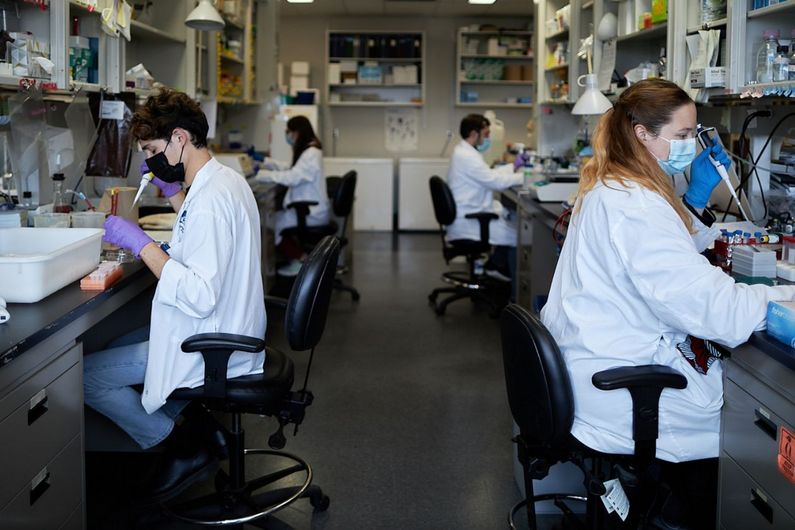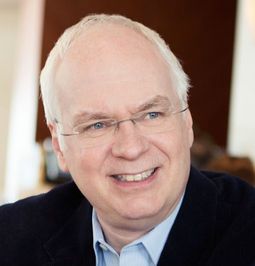Basic research at IRIC spawns commercial drugs
- UdeMNouvelles
05/29/2024
- Martine Letarte
Michel Bouvier, CEO of the IRIC for the past 10 years, is delighted to see his model of combining basic research with drug discovery and commercialization bearing fruit.
During his 10 years at the helm of the Institute for Research in Immunology and Cancer (IRIC), Michel Bouvier, a professor in UdeM’s Department of Biochemistry and Molecular Medicine, has helped shepherd several molecules from the basic research stage all the way to clinical trials.
“This is very rare in the academic setting,” said Bouvier. “But we’ve been able to pull it off by building partnerships with the pharmaceutical industry and creating spin-off companies.”
He pointed to ExCellThera, a spin-off created in 2015 based on research by Guy Sauvageau in the molecular genetics of stem cells and by Anne Marinier in medicinal chemistry. The company is using the UM171 molecule to develop new ways of expanding hematopoietic (blood-forming) stem cells for therapeutic purposes.
“More than 100 patients have already been treated and the results are very positive – it has literally saved lives! And phase 3 clinical trials are set to begin this year,” said Bouvier proudly.
Another example is Epitopea, which grew out of work by Pierre Thibault in mass spectrometry-based proteomics and by Claude Perreault in immunobiology. Founded in 2021, this company develops immunotherapies to treat cancers by targeting a novel class of antigens.
Domain Therapeutics is a France-based pharmaceutical company that conducts R&D in drugs that target G protein-coupled receptors (GPCRs). It opened a subsidiary in Montreal in 2014 and is now using a novel GPCR biosensor technology developed in Bouvier’s lab.
“GPCRs represent the largest family of receptors with over 800 variants, and roughly a third of marketed drugs target these receptors,” Bouvier explained. “My lab is continuing to develop new tools to better understand how GPCRs transit their signals so we can make more effective drugs with less side effects.”
For example, Bouvier’s lab recently elaborated the signaling pathway of the GLP-1 receptor ligands targeted by semaglutide (sold under the brand name Ozempic), a diabetes drug that’s been making headlines lately as a weight-loss aid.
To identify potential therapeutic agents, Bouvier’s team is turning to bioinformatics, computational science and artificial intelligence. “In recent years, we’ve really focused on harnessing the potential of these technologies to speed up drug discovery, in particular by working closely with Mila,” said Bouvier.
From basic research to clinical trials
The key to the IRIC’s success, believes Bouvier, lies in its multi-faculty structure (medicine, pharmacy, arts and science), which is unique in Canada, and its focus on advancing both basic research and the drug commercialization process.
Bouvier joined the IRIC not long after it was founded in 2003 by Guy Sauvageau because he was convinced of the synergetic potential of combining cutting-edge basic research with research maturation to bring innovative therapeutic solutions to market and patients. To tap into this potential, he co-founded the IRIC’s Drug Discovery Unit with Anne Marinier.
While Bouvier saw the importance of transforming discoveries made in the academic setting into treatment solutions, he also wanted universities to benefit financially from this success. To make this happen, he helped found IRICoR, which stands for IRIC – Commercialisation of Research, a not-for-profit organization dedicated to the discovery and commercialization of innovative therapies, and became its director.
“I was already collaborating with the pharmaceutical industry and that experience helped me establish agreements with a number of industry partners,” said Bouvier. “As a result, we’ve been able to generate substantial revenues for the university and the IRIC, which we’ve then re-invested in research.”
While heading IRICoR, Bouvier became the IRIC’s Associate CEO and Marc Therrien its Associate Scientific Director. “Then I took over from Guy Sauvageau when he completed his two terms as CEO in 2014,” he explained.
Attracting top talent
One of Bouvier’s first initiatives as CEO was mounting an annual gala to raise funds in support of ground-breaking discoveries in the fight against cancer. Over the years, the Gala Audace has raised no less than $8 million!
This funding puts the IRIC in a better position to recruit the very best talent. For example, it has been able to update the infrastructure for high-level research that dated from the institute’s founding. “Our 11 technological platforms serve not only the Université de Montréal scientific community, but also researchers in Montreal and the rest of Canada,” Bouvier pointed out. “They are important for creating a stimulating environment for students, post-docs and researchers.”
Bouvier also emphasized the importance of mentoring the next generation, which he and Scientific Director Marc Therrien (until 2023) made a priority. And he underscored the IRIC’s collegial and democratic way of working: “We hold a monthly meeting with all the researchers to discuss our vision and make decisions. People have a sense of belonging.”
As his last term as CEO wraps up, Bouvier hopes the IRIC’s unique model will continue to flourish and grow. “Collectively, we must continue to work hard and be bold – even harder and bolder if that’s what needed – so that other promising discoveries can move out of the university and into patient treatment.”














